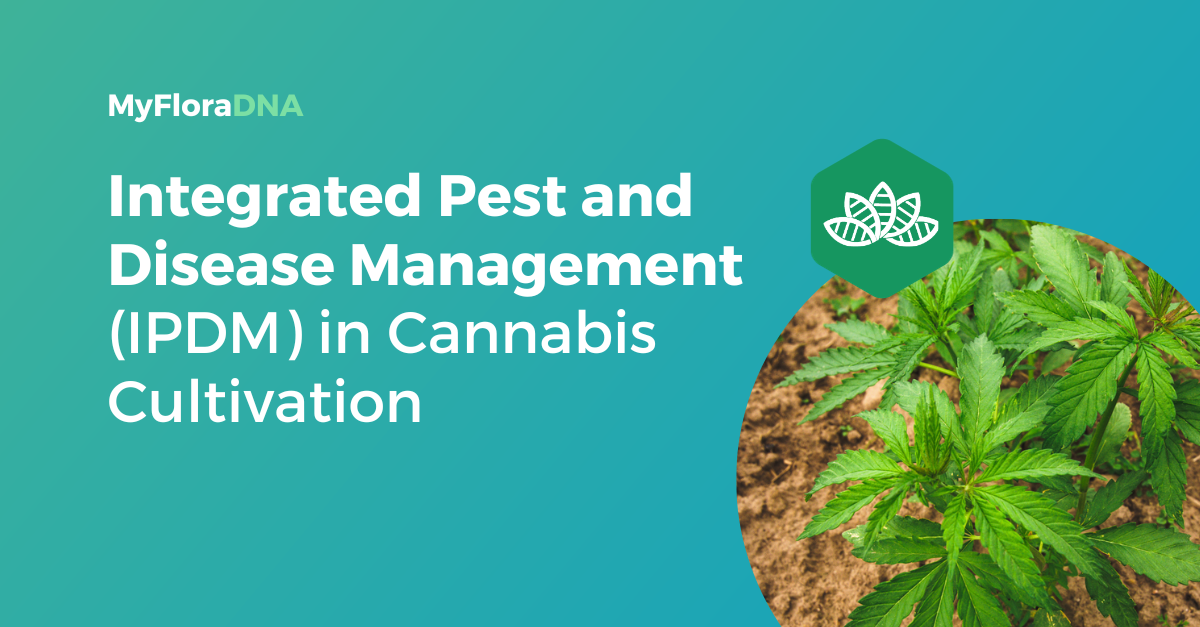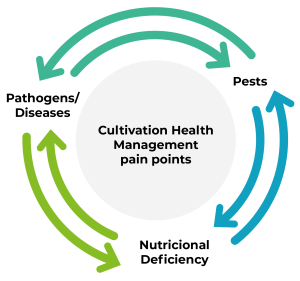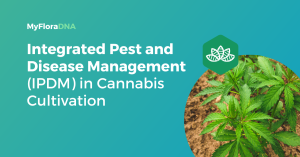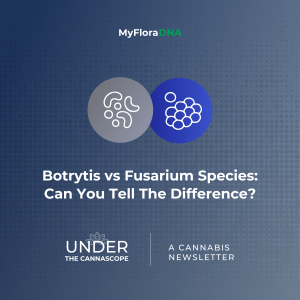
Integrated Pest and Disease Management (IPDM) in Cannabis Cultivation
This blog post is a collaborative production by engaging the top-notch experts in our industry: Matthew Gates, Angel Fernandez, Ajith Anand, Sergio Picazo, and Marcus Purungao.
Share and support cannabis-specialized professionals! 🌱🤝
Defining IPDM and its Importance
Integrated Pest and Disease Management (IPDM) isn’t only managing and preventing pests; it emphasizes sustainable practices that diminish harm to our environment, animals, and humans while acknowledging the intricate interplay between plants, pathogens, pests, and their environments. This is a departure from traditional practices that typically focus on aggressive chemical applications.
To truly understand IPDM, it’s crucial to recognize that not all organisms, such as insects, mites, viruses, fungi, or bacteria, are pests. Many play critical roles in their ecosystems. Some even provide benefits to cultivators. Hence, defining a ‘pest’ requires context. In cannabis cultivation, pests and diseases form a feedback loop and are constant challenges requiring vigilant monitoring.
IPDM vs. Traditional Methods
Traditional plant health practices have typically focused on aggressive chemical solutions. IPDM considers plant health in its totality: the complex interactions between the plant, pathogens, pests, and both the physical and chemical environments. The approach strives to reduce losses while ensuring environmental safety, human well-being, and longer-term agricultural sustainability.
The Crucial Role of Pathogen Management in Cannabis Cultivation
Pathogen management is a non-negotiable element of IPDM, especially for cannabis (both medical and recreational). Reasons include:
- Consumer Health and Safety: Pathogens like Aspergillus can produce harmful mycotoxins that pose health risks.
- Product Quality and Marketability: Diseases can compromise the aesthetic, potency, flavor, and aroma of the cannabis product.
- Crop Yield: Diseases can severely impact the yield of cannabis crops.
- Regulatory Compliance: Pathogen-infested crops may fail to comply with stringent industry regulations.
- Resilience: A plant weakened by pathogens becomes more susceptible to other challenges.
- Chemical Overuse: Proper IPDM can reduce the frequent and perhaps unnecessary use of chemical agents.
Synergy Between Nutrient Deficiency, Pest Control and Disease Management
Pest control and disease management synchronously operate to diminish risks by reinforcing each other’s efficacy and creating an environment less conducive for both pests and pathogens. Specifically:
- Pest-free healthy plants , are better equipped to resist and tolerate diseases due to stronger immune responses. Similarly, plants not weakened by diseases are less attractive to certain pests.
- Some pests can be vectors for pathogens. By controlling these pests, the transmission of diseases is reduced. Conversely, certain pathogens can weaken plants, making them more susceptible to pest infestations.
- Management practices such as crop rotation, sanitation, and soil health improvement simultaneously deter many pests and pathogens by disrupting their habitats and life cycles.
- Introducing beneficial microbes can both suppress soil-borne pathogens and deter pests. Similarly, beneficial insects can prey on pests while improving soil health, indirectly inhibiting disease agents.
- Adjusting factors like humidity and soil moisture can deter both fungal pathogens and pests like spider mites, which thrive in specific conditions.

Common Pest Threats to Cannabis and their Implications
When discussing pests, it’s crucial to understand both the organisms themselves and the consequences of their presence. Cannabis plants face several potential invaders:
- Two-spotted Spider Mite (Tetranychus urticae): These mites are small, either red or green, with dark spots on their bodies. They might be minute at 0.4 mm in length, but the typical damage they cause is hard to miss. They create stippling dots by feeding on plant cells and produce silk, which can spread, thereby protecting the mite population and compromising the quality of the flowers.
- Corn Earworm (Helicoverpa zea): This medium-sized brown moth can be a significant threat. It lays white eggs near flowers. Once hatched, the resulting larvae, or caterpillars, burrow into the flower, potentially resulting in mold-prone micro-environments. Moreover, they leave behind frass inside flowers, compromising the integrity and quality of the bud.
- Rice Root Aphid (Rhopalosiphum rufiabdominale): These 1.4-2.4 mm teardrop-shaped aphids come in green, orange, or black. They’re found on many plants, including Cannabis. These aphids feed on plant sap. While the damage isn’t always visible, it involves disruptions in nutrient dispersal and immune system functions. They can also produce a waste called honeydew that fouls foliage and becomes a substrate on which black mold grows. Evidence suggests they may transmit the Cucumber Mosaic Virus (CMV) and potentially the Hop Latent Viroid (HLVd) to Cannabis.
- Cannabis Aphid (Phorodon cannabis): These are 1.5-2.5 mm teardrop-shaped aphids, either dark or pale green. Unlike many aphids, they specialize in one host: Cannabis. Like other aphids, they feed on sap and can disrupt plant nutrient dispersal and immune system functions.
Check out this video to learn more about how to prevent and manage pests in cannabis.
The economic losses and damage caused by the pests and diseases in cannabis underscores the need for a robust IPDM strategy. Healthy plants and good cultivation practices are paramount to minimize the damage caused by pests and diseases.
Pillars of an IPDM Strategy for Cannabis
Building a robust IPDM strategy requires:
- Using certified pathogen-free seeds and clones.
- Incorporating cultural practices that promote plant health.
- Implementing safety protocols for pest and disease identification.
- Utilizing cutting-edge solutions to identify and prevent diseases.
- Encouraging the use of biological controls.
- Reserving chemical pesticides as a last resort. Soon we will dive deeper into this topic, and how synganic (synthetic+organic) approaches can help you leverage your IPDM strategy.
Remember, the primary goal isn’t to eradicate pests and diseases completely but to prevent their establishment and keep the damage below economic injury levels.
Importance of Monitoring in IPDM & Tools for Effective Identification
Successful implementation of IPDM hinges on continuous monitoring and early detection. It’s essential to have state-of-the-art technologies and diagnostic tools to manage pests and pathogens precisely.
MFDetect™: A Cannabis-Focused Solution for Disease Detection
MFDetect™ is our proprietary plant pathogen detection assay, designed specifically for the unique challenges faced by cannabis cultivators. This high-throughput, cost-effective solution marries two established technologies to pinpoint pathogens precisely, including threats like the Hop Latent Viroid.
Backed by a team of scientists with decades of expertise in genomics, plant biology, and breeding, MFDetect™ offers more than just detection. We recognize the uniqueness of every operation. That’s why we extend customized solutions tailored to meet each client’s distinct needs and optimize their crop production and cultivation management practices.
With tools like MFDetect™, the future of cannabis cultivation promises both sustainability and efficiency, guaranteeing productivity while ensuring safety.
Bibliography
- Ciancio, A., & Mukerji, K. G. (Eds.). (2007). General concepts in integrated pest and disease management (No. 04; SB611. 5, G4.). New York, NY, USA:: Springer.
- Julian B Cosner, Jerome F Grant, Influence of varieties of hemp, Cannabis sativa (Rosales: Cannabaceae), and fertilization rates on damage caused by corn earworm, Helicoverpa zea (Lepidoptera: Noctuidae), Environmental Entomology, 2023;, nvad063, https://doi.org/10.1093/ee/nvad063
- Fernandez i Marti, A., Parungao, M., Hollin, J., Selimotic, B., Farrar, G., Seyler, T., Anand, A., et al. (2023). A Novel, Precise and High-Throughput Technology for Viroid Detection in Cannabis (MFDetectTM). Viruses, 15(7), 1487. MDPI AG. Retrieved from http://dx.doi.org/10.3390/v15071487
- Horowitz, A. R., & Ishaaya, I. (Eds.) (2014). Integrated Pest Management: Current Concepts and Ecological Perspective. Academic Press.
- McPartland, J. M., Clarke, R. C., & Watson, D. P. (2000). Hemp diseases and pests: management and biological control: an advanced treatise. CABI.
- Peshin, R., & Dhawan, A. K. (Eds.) (2009). Integrated Pest Management: Innovation-Development Process. Springer.
- Pretty, J., & Bharucha, Z. P. (2015). Integrated pest management for sustainable intensification of agriculture in Asia and Africa. Insects, 6(1), 152-182.
- Punja, Z. K. (2021). Emerging diseases of Cannabis sativa and sustainable management. Pest management science, 77(9), 3857-3870.
- Punja, Z. K., Ni, L., Lung, S., & Buirs, L. (2023). Total yeast and mold levels in high THC-containing cannabis (Cannabis sativa L.) inflorescences are influenced by genotype, environment, and pre-and post-harvest handling practices. Frontiers in Microbiology, 14, 1192035.
- Punja, Z. K., & Scott-Dupree, C. (2022). Cannabis IPM–insect pests and diseases. Frontiers in Agronomy, 4, 1052181.
- United States Environmental Protection Agency (EPA). (2018). Introduction to Integrated Pest Management. U.S. Environmental Protection Agency.




